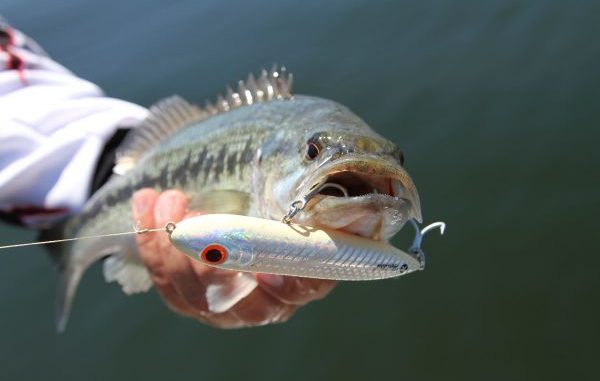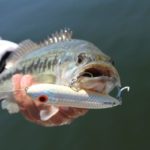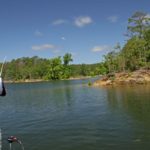
You could switch to soft-plastic lures and flip cover when the heat rises this month — or you can adjust your approach to fishing topwater lures and watch bone-crushing strikes.
So I’m sitting in the middle of the lake with Bassmaster Elite Series pro Terry Scroggins as he chats boat-to-boat with a fellow tournament pro, when the telltale flipping, splashing and ravenous commotion signalled schooling bass even before we turned our heads for visual confirmation.
Scroggins is known for carrying baits for any possible scenario, but this was an easy decision.
He grabbed a Zara Spook Jr., fired it toward the fracas and drew a strike after maybe a half dozen twitches.
“Look at him — he’s all over it,” Scroggins said of the unbridled schooling bass aggression that delivered the timeless entertainment that has buoyed the popularity of topwater fishing for decades.
Bobby Murray — the first Bassmaster Classic winner and topwater aficionado — pointed to Heddon’s Spook lineup as his go-to bait choices from the time spring water temperatures reach about 65 degrees all the way through the fall when bass start targeting bigger baitfish. A range of sizes from 3 to 7 inches affords Spook-casters a diverse arsenal, Murray said.
“People think a topwater is just for catching fish in shallow water, but it’s much more versatile,” Murray said. “There are times in the spring when you can catch fish on a Spook in 4 to 5 feet of water.
“But there are also times that I can literally be sitting in (over 30) feet of water, throwing over a deep hump or some submerged trees and have the ability to call that fish all the way to the surface.”
When selecting topwater baits, it’s wise to stock your box with a mix of “walkers” and “poppers.”
Walkers, like Murray’s Spook — along with Rapala X-Rap Walk, Lucky Craft Sammy and the Jackall Bowstick — generally feature a cigar profile with smooth, rounded faces. Designed to work back and forth with the classic walk-the-dog motion, these baits look like a wounded or disoriented bait wandering across the surface.
For a more-active display, poppers/chuggers like the Yo-Zuri Sashimi Popper, Strike King Spit’N King, Storm Chug Bug, Rebel Pop-R and Rowland’s signature XCalibur Zell Pop feature concave faces that push water when snapped across the surface. Make them spit, chug, pop or bloop — this commotion announces the bait’s presence like a carnival hawker with a bullhorn.
With either style of bait, sound effects can greatly enhance the appeal. The generic term “rattles” gets the point across, but it’s often used to broadly. The fact is that you can find topwaters with multiple small rattles that imitate the frantic sounds of a baitfish school or models like the Spook One Knocker whose single low-pitch thumping sound might give that distant fish an audible trail that helps locate your bait.
“We can change our presentation by what is inside the lure, not only how the lure works,” Murray said.
When it comes to topwater retrieves, walkers vary mostly by cadence — how quickly each side-to-side move is made.
Poppers, on the other hand, offer a little more variance. For starters, you can ditch the straightforward popping and go with a walking retrieve.
For popper prowess, few names rival that of Bassmaster Elite pro Zell Rowland. He, too, sees widespread applicability for the topwater game.
“I get asked all the time, ‘When do you like to throw a topwater bait,’ and my answer is usually ‘When nobody else is,’” Rowland said.
That being said, different scenarios call for different looks. For simplicity, he breaks down his retrieve options by seasonal temperature:
• Cool Weather — “When the water is anywhere from 58 to 64 degrees, I have a tendency to work the bait quite a bit slower,” Rowland said. “When the water’s cold, I have a tendency to chug it more so it makes a blooping sound — sort of like a frog swimming across the water.”
• Warm Weather — “As the temperature rises to 64 to 70, I’ll change the cadence to where I’m speeding the bait up more,” he explained. “I’ll also make the bait spit and chug at the same time.”
• Hot Weather — “When the water reaches 70, 80 or 90 degrees in the summertime — especially if the water’s clear — I don’t like to work the bait extremely slow. I don’t want to give the fish a long time to look at the bait. I want him to look at that bait and think it’s a shad running, so I’ll have a tendency to move that bait extremely fast while making the bait spit and walk at the same time.”
Rowland also factors wind conditions into his topwater presentations. Slick-calm days allow fish to see and hear surface activity from long distances. On a windy day, however, he’ll go heavy on the chugging action to maximize his chances of getting his bait noticed amid the waves.




